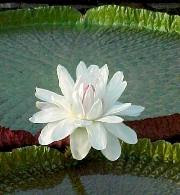Aquatic Giants
 During the summer of 1991 I had the good fortune of being selected to participate in the internship program at Longwood Gardens in Kennett Square, PA. I had the even better fortune of being selected to serve my term under the guiding hand of Patrick Nutt, a renowned expert on all things horticulture, but even more renowned for his voluminous knowledge of aquatic plants and gardens. It was here, under Pat’s expert guidance, that I first laid eyes on and eventually got to work with one of the most-revered aquatic plants in the world–the giant waterlily, Victoria.
During the summer of 1991 I had the good fortune of being selected to participate in the internship program at Longwood Gardens in Kennett Square, PA. I had the even better fortune of being selected to serve my term under the guiding hand of Patrick Nutt, a renowned expert on all things horticulture, but even more renowned for his voluminous knowledge of aquatic plants and gardens. It was here, under Pat’s expert guidance, that I first laid eyes on and eventually got to work with one of the most-revered aquatic plants in the world–the giant waterlily, Victoria.
There are two species in the genus Victoria, V. amazonica and V. cruziana.
In 1961, Pat created the first hybrid between the two species and the rest is history. Victoria x ‘Longwood Hybrid’ set the bar for giant waterlilies for nearly 40 years until the cross was re-made in the late ’90’s by enterprising water garden enthusiasts Kit and Ben Knotts of Cocoa Beach, Florida.
So what is this giant waterlily? Where did it come from? Both species, Victoria amazonica and Victoria cruziana, are native to South America, the former found in the lowland rivers and lakes of the Amazon river basin, while the latter is found in higher elevations of Paraguay, Bolivia and Argentina. Both are, obviously, of tropical origin, but because V. cruziana grows at higher elevations it is more tolerant of cooler temperatures. This ability to tolerate cooler temperatures is what has made it an indispensible parent to its hybrid progeny, giving gardeners in more temperate climes the ability to grow these magnificent plants.
It was a thrill for me, as a young horticulture student barely 20 years old, to work with both a renowned plant and a renowned plantsman. It was an even greater thrill when Pat invited me to join he and several others at Longwood’s famous water garden one evening to assist in the process of making the cross between the two Victoria species that results in Longwood’s namesake hybrid. The process was fascinating–everyone in hip waders, squeezing in between the gigantic, platter-like leaves some of which approached nearly 6 feet in diameter and viciously armed along their stems and undersides with inch-long spines. Pollen was transferred from flower to flower and those that “took” would sink below the water’s surface to form a seed pod that would eventually be harvested and the seed stored for the following year’s display.
These giant “water platters” are some of the most fascinating plants that I have had the opportunity to work with. As I already mentioned, they are viciously armed with spines that may be an inch long in some cases and wickedly sharp. But when you live in the Amazon, you have to learn to protect yourself from things that might decide you’re a delicacy! Before you get up close and personal enough to notice their spines, though, it’s their sheer size that never fails to impress; individual leaves may reach as much as 6 feet across on a well-grown specimen. The underside of the leaves is an intricate tapestry of veins that look for all the world like an art nouveau stained glass window and the rim of the leaf turns up around the edges, standing as much as 4 inches high in some plants.
Perhaps the most anticipated event of all, though, is the plant’s flowering, which happens at night and adds greatly to the plants’ mystique. The buds, too, are covered in spines and grow to about the size of a goose egg as they break the surface of the water. On the first night’s opening they are pure white and the size of a dinner plate, exuding the fragrance of pineapple as they float on the water’s surface. At dawn the following day, they close, and upon re-opening for their second night’s display have turned rosy pink. This display will continue on for several weeks, through late summer and well into the fall if the water temperature remains warm.
Victoria lilies are available from time to time from several of the mail order water gardening nurseries. Don’t let their ultimate size discourage you, as their growth will match the size of the pond they are growing in (within reason). They still need a little elbow room, but if you have a nice sized pond, it would be fun to give one a try. Even if you only get leaves 3 feet across, who else do you know who has a water lily that size???
For some beautiful photographs and a considerable amount of information about the amazing Victoria lilies and their hybrids, click here: http://www.victoria-adventure.org/victoria/victoria_identification.html
